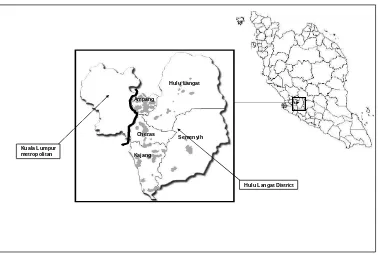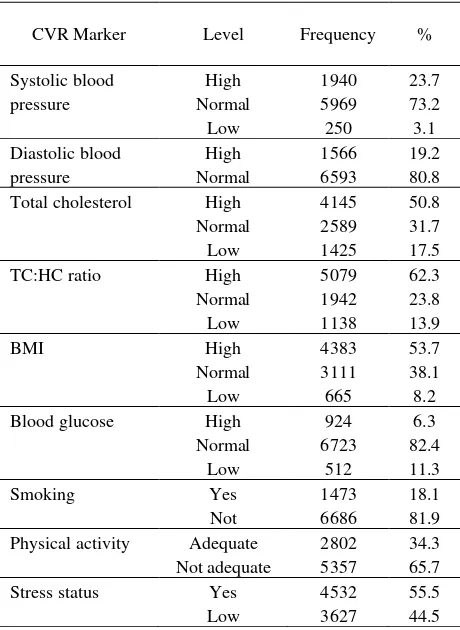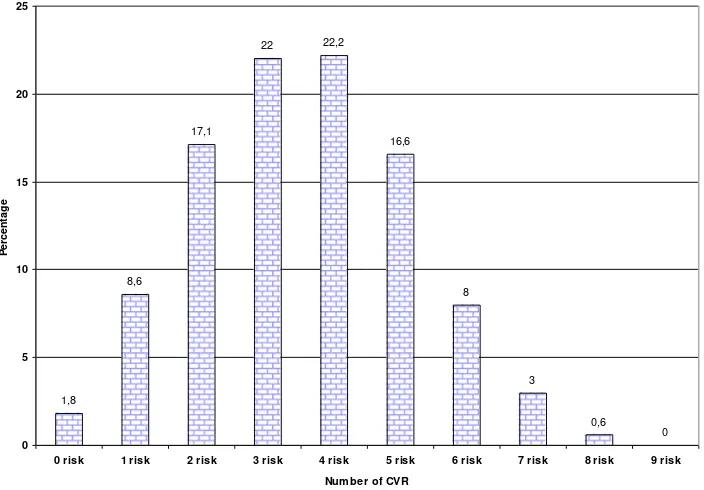Lifestyle dominates cardiovascular risks in Malaysia
Khalib Abdul Latiff1, Khairul Hazdi Yusof2
Abstrak
Penyakit kardiovaskular merupakan penyebab kematian utama di Malaysia baik di kota dan pedesaan. Untuk pencegahan dan penanggulangan masalah ini perlu disusun menurut prioritas beberapa faktor risiko. Tujuan artikel ini ialah untuk mengidentifikasi beberapa faktor risiko penyakit kardiovaskular yang dominan. Satu penelitian potong lintang komunitas dilakukan pada Maret 2000 – Juni 2001 terhadap 8159 penduduk pinggiran kota dan pedesaan yang berusia 18 tahun ke atas untuk melihat prevalensi faktor risiko utama penyakit kardiovaskular. Faktor risiko yang diteliti adalah tekanan darah sistolik, tekanan darah diastolik, kadar kolesterol dan glukosa darah, indeks massa tubuh, kebiasaan merokok, aktivitas fisik, dan tingkat ketegangan mental. Prevalensi faktor risiko utama penyakit kardiovaskular pada umumnya tinggi yang didominasi oleh kurang aktivitas fisik (65.7%), peningkatan kolesterol – TC:HC (62.3%), ketegangan mental (55.5%), obesitas (53.7%), dan merokok (49.9%) terutama di antara lelaki. Beberapa prevalensi meskipun meningkat menurut umur akan tetapi relatif rendah: prevalensi tekanan darah sistolik (23.7%) dan diastolik (19.2% serta penyakit kencing manis (6.3%). Faktor risiko kardiovaskular yang berkaitan gaya hidup ternyata jauh lebih prevalens dibandingkan dengan faktor risiko akibat pengaruh biologi. Oleh karena itu inisiatif upaya kesehatan masyarakat harus dipacu untuk mencegah dan mengontrol faktor risiko yang berkaitan gaya hidup. (Med J Indones 2008; 17: 50-6)
Abstract
Cardiovascular problem is one of the leading cause of death in Malaysia and now invaded to the sub-urban and rural areas. To prevent and control of this problem, several main risk factors needed to be known and shall be reexamined and ranked according to the priority. The objectives of this research paper was to identify several dominant risk factor related to cardiovascular problem. A cross sectional study was carried out from March 2000 – June 2001 on a total of 8159 rural population aged 18 and above to measure the prevalence of the common cardiovascular risk factors. Those risk factors are systolic blood pressure, diastolic blood pressure, serum cholesterol level, obesity index, blood glucose level, smoking, physical activity and mental stress. Overall prevalence of common cardiovascular risk factors were higher, dominated by physical inactivity (65.7%), hypercholesterolemia – TC:HC (62.3%), mental stress (55.5%) and obesity (53.7%). Smoking was also high at 49.9% especially among men. However systolic hypertension, diastolic hypertension and diabetes mellitus; although increased by age, its prevalence is relatively low at 23.7%, 19.2%, and 6.3% respectively. Cardiovascular risk factors related to lifestyle are much evidenced as compared to risk factors related to the biological influence. Therefore, all initiatives in community health intervention should be mobilized specifically on prevention and control of lifestyle-related risk factors. (Med J Indones 2008; 17: 50-6)
Keywords: cardiovascular problem, community intervention, lifestyle-linked risk factors
Cardiovascular disease (CVD) particularly coronary an heart diseases, stroke and heart failure, is becoming important public health problem in the developing country affecting the majority of people especially adults.1 It has been estimated that by year 2020, a total of 20 millions people would die because of CVD
globally.2 In Malaysia, this issue has persistently ranked the top five for several years in morbidity, mortality as well as the number of hospitalization.3
This CVD outcomes can be linked to so many risk factors, but most important one is the lifestyle or behavior of the people. However, the lifestyle profile of whom at risk is changing. CVD is no longer a disease that primarily affects elderly people, it has become a killer of everyone including women and young adult. Specific segments of the population are at greater risk than others. This development is attributed 1 Department of Community Health, Faculty of Medicine,
Universiti Kebangsaan Malaysia, Kuala Lumpur, Malaysia 2 Hospital Universiti Kebangsaan Malaysia, Kuala Lumpur,
primarily to a higher incidence of significant and established risk factors such as smoking, hyper-cholesterolemia, obesity, unhealthy diet, stress and physical inactivity beside a well known hypertension and diabetes mellitus.4-,11
It has been agreeable that preventive and control strategies in the form of health promotion campaigns, health screening and compliance with medication and others remedies are the vital approaches in curbing this problem. However, the current CVD trend has indirectly indicated that the available strategies have failed to minimize the problem. One of the major obstacle is that, it is not well focused and targeted.12 Therefore, it is time to have a well planed and lasting programs or activities to focus specifically on the factors that are genuinely associated with the CVD.
In Malaysia, Hospital Universiti Kebangsaan Malaysia (HUKM) has set up and initiated a comprehensive and long term Hulu Langat Health Development Project where one of its main study is on CVD. The CVD study which was launched in 1999, is community-based study aimed at continuously measure the prevalence of CVD risk factors and its associated outcomes. This paper highlights some of the important findings on CVD risks that could be very useful in developing community based preventive and control initiatives against CVD risks factor.
METHODS
A cross sectional study was carried out from March 2000 – June 2001 in district of Hulu Langat, Selangor, Malaysia, involving sub-districts namely Ampang, Semenyih, Kajang, Hulu Langat, and Cheras. By using the Fisher Random numbers in each respective sub-district, about 25% of the sampling units (households) were selected using stratified random sampling according to the type of residence (traditional village and modern housing area). All members (approximately 42% or about 10,000) age 18 years or older have been considered respondents.
A structured and pre tested general health assessment questionnaire was used to collect respondent’s particulars. The questionnaire was divided into three main categories namely: (a) socio-demographic data (age, sex, ethnic group, educational level and occupation); (b) biological data (systolic blood pressure, diastolic blood pressure, glucose level and lifestyle–linked biological data namely total cholesterol, HDL-cholesterol
to measure TC:HDL ratio, weight and height to measure body mass index – BMI for obesity) and (c) behavior data (smoking, physical activity and stress level). Both biological and behavior data were collectively identified as cardiovascular risk (CVR) markers or factors. Factors such as genetic marker, diet habit, Waist-Hip ratio and others factors were purposely excluded from this study.
In this study age was determined by comparing date of interview to date of birth stated in the birth certificate or identity card. Whereas sex, ethnic group, education level and occupation status were collectively acquired through interview. Blood pressure was measured using manual sphygmomanometer on their arm while patient on a sitting position. Average reading was used based on reading that was taking five minutes apart. Both cholesterol and glucose were measured using Bioscanner Strips respectively. Obesity was assessed using the Seca Body meter, where the BMI was measured. Here, weight (in kg) and height (in meter) of respondent was measured when they were asked to stand with bare foot with minimal clothing.
Systolic and diastolic hypertension were analyzed using JNC VII standard criteria.13 As to cholesterol, hypercholesterolemia was considered if the ratio total cholesterol and HDL-cholesterol (TC:HC) was more than 4.0 and normal (3.0 - 4.0) and low (<3.0). Obesity was diagnosed when the BMI more than 25, normal (18-25) and low (<18). For diabetic status, hyper-glycemia was labeled when blood glucose more than 10 mmol/l, normal (3-10 mmol/l) and low (<3 mmol/l). As for the behavior data, smoking was measured if the respondent was currently an active smoker regardless of the duration, number and type of tobacco. Physically inactive respondent was labeled if respondent was not exercising or exercising less than three times per week for at least 30 minutes each. Exercise in this study was defined as any structured physical activity such as aerobic exercise, sport, game, physical tournament, physical competition etc. and unstructured physical activity such as walking, jogging and swimming. Stress status was measured based on the capability of the respondent dealing with various stressor in his/her surrounding. Respondent was considered stressful if he/she experienced of a little upset to certain stressor.
RESULTS
Geographical condition of study area
Study district was a mixed of semi-urban and rural and known as Hulu Langat district, located south-easterly of Kuala Lumpur metropolitan. Almost two third of the population concentrated in both Ampang (50%) and Cheras sub-districts (19%), whereas Kajang, Hulu Langat and Semenyih are 16%, 8% and 7% respectively.
In general, proportion of modern housing area is much more dominant compared to the traditional village; with approximately six housing areas to every one traditional village (Figure 1).
Socio-demographic data
A total of 5187 households were surveyed and covering of 8159 respondents aged 18 years old and over. This gave a response rate of 81.6%. Logistic constraints
and respondent’s unavailability at time of visit were
the main factor of the non response cases. Uncooperative cases however, were small and insignificant.
By age group, those less than 30 years old were 22.6%, 30 – 39 years old (21.3%), 40 – 49 years old (25.3%),
50 – 59 years old (16.4%), 60 – 69 years old (9.9%) and above 70 year (4.5%). About 36.0% were men and 64.0% were female. As to the ethnic different, 81.5% were Malay, 9.8% Chinese, 8.3% Indian and others 0.3%. Majority of respondents were stayed in Ampang (44.7%), followed by Kajang (23.6%), Cheras (18.8%), Hulu Langat (8.0%) and Semenyih (4.9%) respectively.
In term of educational level, majority were completed up to the secondary school level (76.0%), followed by non-attendant to school (11.6%), higher school (7.5%), college education (4.8%) and university (0.1%). As to the occupation, majority were employed in various sectors (45.3%), then students (30.9%), housewife (14.4%), unemployed (5.4%) and pensioner (4.0%).
Prevalence of CVR marker overall
As shown in Table 1, the highest prevalence of CVR markers was physical inactivity (65.7%), followed by high TC:HC ratio (62.3%), stress (55.5%), obesity (53.7%), high cholesterol (50.8%), high systolic pressure (23.7%), high diastolic pressure (19.2%), smoking (18.1%) and the lowest being hyperglycemia (6.3%).
Figure 1. District of Hulu Langat showing the showing the population density of its sub-district Kajang
Ampang
Semenyih Cheras
Hulu Langat District Kuala Lumpur
metropolitan
Table 1. Prevalence of CVR marker
Total cholesterol High
Normal
Blood glucose High
Normal
Physical activity Adequate
Not adequate
2802 5357
34.3 65.7
Stress status Yes
Low
4532 3627
55.5 44.5
Prevalence of CVR marker by gender
Table 2 shown that four main markers were physical inactivity, hypercholesterolemia (as indicated by high TC:HC ratio), stress and obesity were the most dominant CVR markers regardless of gender. It was 72.4%, 71.5%, 56.3% and 55.1% respectively in men and 61.8%, 57.1%, 55.1% and 53.0% respectively among women. For men, it was further added by smoking (49.9%).
CVR markers like systolic blood pressure, diastolic blood pressure and blood glucose were generally low in its prevalence. For men, it was 24.3%, 22.6% and 7.0% respectively and 23.5%, 17.3% and 5.9% among women.
Prevalence of CVR marker by age
It was well documented that most CVR markers particularly biological parameters were changed with age. In this study, all markers were closely examined. As shown in table 3, some markers were steadily increased with age, some decreased.
Markers that were markedly increased with age were hypercholesterolemia, obesity, systolic hypertension, diastolic hypertension and hyperglycemia. Both hyper-cholesterolemia (as revealed by TC:HDL ratio) and obesity were progressively increased dominating more than half of the respondents across all the age group. For systolic hypertension, its increment was steady and only dominated half of the respondents after they reached 60 years old. However, change in diastolic hypertension was much slower and only affecting less than one third of the respondents in each age class. As for hyperglycemia, although it became double at age of 50 years old, but its prevalence was relatively very low.
In contrast, although physical inactivity and stress were extremely prevalence (more than 70% and 60% respectively), both prevalence were slowly decreased with advancing age. For smoking habit, its prevalence was steadily maintained at 16-17% (<50 years old category) and slightly increased at 20-21% (>50 years old category).
It was also interested to note that in general, prevalence of CVR marker was relatively low amongst the elderly people >70 as compared to those < 70 segments. This was evidenced for diastolic hypertension, hyper-cholesterolemia, obesity, hyperglycemia, physical activity and stress. However, for smoking, there were about 20.4% respondents in this group were still smoking. Nevertheless we were not able to provide details of their health status although some of CVD might already established in theirs.
Prevalence of CVR marker by ethnic group
Table 2. Prevalence CVR marker by gender
Overall n=8159 1940
(23.7)
Table 3. Prevalence CVR marker by age group
CVR marker by
Overall n=8159 1940
(23.7)
Table 4. Prevalence of CVR marker by ethnic group
CVR marker
Proportion of respondents with multiple CVR markers
We were also examining the proportion of respondents with multiple CVR markers as specified out in this study. As can be seen in Figure 2, only 1.8% of total respondents carried no CVR marker and 8.6% with one CVR marker. But majority of respondents presented
Figure 2. Proportion of respondents by number of CVR markers
DISCUSSION
This study has clearly shown that several CVR markers were prevalence in this sub-urban and rural community. This observation was persistent regardless of gender and ethnicity. Although some of the risk factors were relatively prevalence to certain ethnic, this finding was generally quite consistent and similar to the national and global trend to indicate that this issues were already a pandemic problem.14,15
It appeared that behavior or lifestyle factor has dominated most of CVR markers of CVD. It affected more than half of the respondent. Of all the markers, hypercholesterolemia seemed to be the most alarming factors that linked very closely to eating and living style of the people. Its constant rising trend across all age group has indicated that unhealthy diet still remained a major health problem that needed to be seriously reviewed. Next factor would be smoking especially among men. Although its prevalence was relatively constant across all age, this habitual practice would further endanger people’s lives because of its synergic effect with the other markers. This study has evidently shown that more than half of respondents possessed 2 – 4 CVR markers.
On the other hand, some factors surprisingly have shown an opposite trend. Physical inactivity and stressful living for instance, were slowly walked away as age was advancing. Similarly with obesity, although its decreasing trend appeared a bit late (at the age of 60). This positive trend has clearly indicated that the people has already value the important of health. It also indicated and perhaps proven that the current health campaign has slowly yield its effect.16
What was interesting to note was that the real biological markers such as blood pressure and blood glucose were not so alarming. Although they increased with age, its prevalence was generally much lower when compared to behavior and lifestyle-linked biological factors.
Based on the findings, it was ideal if public health approaches should be geared into: (1) Strengthening the existence exercise promotion activities; (2) Developing new approaches and strategies in controlling overeating phenomena; (3) Advocating coping skills against various stressor; (4) Strengthening cigarette smoking cessation activities; and (5) Improving compliance on medication through family support. These activities certainly needed to be properly planned and executed so that the main CVR factors can be minimized parallel with their age increment.
1,8 8,6
17,1
22 22,2
16,6
8
3
0,6 0
0 5 10 15 20 25
0 risk 1 risk 2 risk 3 risk 4 risk 5 risk 6 risk 7 risk 8 risk 9 risk Num ber of CVR
P
e
rc
e
n
ta
g
CONCLUSION
Prevalence of CVR factors were generally higher, dominated by behavior and lifestyle-linked markers. Some of these practices were quite alarming particularly eating practice and smoking habit. But, sedentary lifestyle and stress coping were slowly decreased as age was advancing. Also, it could be partly because of people were already value the important of health. Biological factors, although they were increased by age, but their present were not so prevalence.
REFERENCES
1. Reddy KS, Yusuf S. Emerging epidemic of cardiovascular
disease in developing countries. Circulation. 1998; 97:
596–601.
2. MacKay J, Mensah AG. The atlas of heart disease and
stroke. WHO and CDC; 2004
3. Ministry of Health Malaysia. Statistic list. Cited 2007
October 19. Available from http://www.moh.gov.my/ MohPortal/statPublic.jsp
4. Berrios X, Koponen T, Huiguang T. Distribution and
prevalence of major risk factors of non-communicable diseases in selected countries: the WHO Inter-Health
Program. Bull World Health Organ. 1997;75:99–108.
5. Mazzone T. HDL Cholesterol and atherosclerosis. Lancet.
2007;370:153-60.
6. Orio F Jr, Palomba S, Cascella T, Savastano S, Lombardi
G, Colao A. Cardiovascular complications of obesity in adolescents. J Endocrinol Invest. 2007; 30:70-80.
7. Muzio F, Mondazzi L, Harris WS, Sommariva D, Brandi
A. Effects of moderate variations in the macronutrient content of diet on cardiovascular. Am J Clin Nutr. 2007; 86:946-51.
8. Robinson JD, Cinciripini PM. The effects of stress and
smoking on catecholaminergic and cardiovascular response. Bahav Med. 2006; Spring:32:13-8.
9. Slentz CA, Houmard JA, Kraus WE. Modest exercise
prevents the progressive disease associated with physical inactivity. Exerc Sport Sci Rev. 2007;35:18-23.
10. Haider AW, Martin GL, Stanley SF, Daniel L. Systolic
blood pressure, diastolic blood pressure and pulse pressure as predictors of risk for congestive heart failure in the Framingham Heart Study. Ann Intern Med. 2003;138:10-6.
11. Rodriguez-Manas L, Castro M, Manzarbeitia J.
Cardiovascular Risk and Diabetes in old people. Br J Diabetes Vasc Dis. 2005:5:7-11.
12. Thelle D. Prevention of cardiovascular diseases: a
scientific dilemma. Scand Cardiovasc J. 2000;34:103–5.
13. Reference card from seventh report of the national joint
committee on prevention, detection, evaluation and treatment of high blood pressure (JNC 7); NIH Publication; 2003.
14. Soi LC. My Live 2006. Proceeding of the 3rd Malaysian
cardiovascular interventional symposium with live transmission; 2006 July 13; Kuala Lumpur.
15. McDermott M. The international pandemic of chronic
cardiovascular disease. JAMA. 2007;297:1253-5.
16. Cutter J, Bee YT, Suok KC. Levels of cardiovascular



